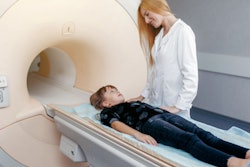Communication and engagement with child-life specialists are a couple of factors in successful MR imaging for young children, according to research presented May 4 at the International Society for Magnetic Resonance in Medicine (ISMRM) meeting in Singapore.
A team led by Yin Ting Chiu, PhD, from the Hong Kong Children’s Hospital discussed key factors identified by the hospital’s MR team for effectively performing supplementary MRI scans on children ages three to seven without sedation.
“With the increasing demand for MRI, the efficient use of MR suits has become a global issue,” Chiu and colleagues highlighted. “Introducing non-sedating MR scanning skills for young pediatrics could save both preparation and table time and therefore boost the scanning efficiency.”
Performing MRI scans on young children can be challenging for radiologists. The researchers noted that children in the three to seven age range may lack understanding and patience in undergoing scans and as a result, can experience anxiety. Along with that, separation from parents and being exposed to loud noises from MRI scanners can increase their distress and potentially hinder successful scanning. The team also pointed out that immobilization methods such as soft pads and sandbags are often ineffective for these patients, and anesthesia can have unwanted side effects.
The researchers highlighted that the MR team of the Hong Kong Children's Hospital implemented strategies like child-friendly rooms, audio-visual systems, child-life specialists, optimized protocols, shorter scan times, and parental accompaniment. Based on these strategies, Chiu and colleagues identified the following five key factors in successfully performing MRI scans on pediatric patients:
- Providing a child-friendly environment: This includes incorporating child-friendly elements into designing scan rooms and having equipment to create a calm and pleasant environment for patients. Adopting an MRI-compatible audio-visual system such as video goggles and headphones can provide entertainment programs such as movies during scans.
- Developing rapport and trust with patients: Engaging with child-life services can allow young children to actively participate and better understand the MRI exam process in a simulation or play environment and foster parent-child communication. Having support from a child-life specialist inside the scan room can help children stay calm and cooperative.
- Communication among practitioners: Effective communication between radiographers, radiologists, and child-life specialists is needed to discuss scan protocols, streamline the exam, and minimize table time.
- Tailoring scan technique and shortening scan time: When clinically appropriate, radiologists can perform plain scans without intravenous contrast injection. Without needles, pediatric patients may be more willing to follow instructions and cooperate during the scan. Minimizing scan durations, limiting the number of sequences, and using fast and single-shot sequences can also increase the chances of obtaining clear images while also improving the overall success rate.
- Parental support: Allowing parents, guardians, or soft toys to accompany the child during the imaging process can provide comfort and reduce anxiety. The team also added that the parent-child combo is also useful.
The team highlighted that while pediatric MRI has its share of challenges, its high contrast resolution and radiation-free methodology make the modality pivotal, especially in directing an appropriate treatment plan.
“By considering these factors and implementing strategies to address them, healthcare professionals can significantly improve the success rate of MRI scans for pediatric patients,” the researchers wrote.



















